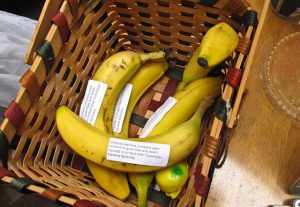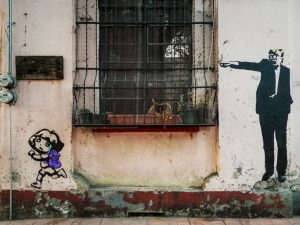Valeria Fajardo
Valeria Fajardo

My name is Valeria Fajardo and my work is An Analysis of Residente’s Protest Anthem: “This is Not America.” For this portfolio, I’ll be using a CC-BY-NC license.
Introduction:
In this portfolio I will be analyzing how rapper Residente’s 2022 music video, “This is Not America” relates to the socio-political development of Latin America. This video not only brings to light various conflicts currently taking place throughout Latin America, it also encourages its audience to consider the United States’ cultural and societal attitudes reading its place in the American continent.
Themes:
Residente’s 2022 music video and song, “This is Not America,” highlights many of the ongoing conflicts present in Latin America: political turmoil, military and police abuse, and the exploitation of indigenous peoples. The music video and song lyrics also expose the cultural erasure of the American continent as a whole, by the linguistic adaptation of the United States becoming known as ‘America’.
Analysis:

Residente, whose name is Rene Perez Joglar, is a Puerto Rican rapper, singer, and producer who was originally known for his rap group, Calle 13 (Thom Jurek). From the beginning, the group had a socially aware approach to their music, addressing topics such as FBI raids, the lives of Latin America’s indigenous and Afro-Latinx minorities, religious prejudices, and political corruption. Residente’s artistic philosophy is stated on his website as “I AM RESIDENTE. I DECIDED TO MAKE MUSIC BASED ON MY DNA, SO I TRAVELED THE WORLD DISCOVERING SOUNDS AND UNCOVERING STORIES. WE ARE ALL RESIDENTS IN THE SPACES THAT CONFINE US. ONLY HERE, THERE ARE NO BORDERS.” Following this introduction, the website reflects Residente’s ideology of no borders by showing a map which shows where the visitor (of the website) is currently placed in relation to him and other significant places (mapped by him). This map however, has no borders and only names a handful of countries (Residente’s ancestral countries). “This is Not America” is a natural extension of Residente’s career-long themes, which center around advocacy for the colonized cultures which are yet to receive reparations, and are instead in a new state of ‘colonialism’ by the United States, “excluding the rest of the history and doing whatever they [the U.S.] want with the name of a continent… it’s kind of like getting colonized again, by the U.S” (Residente).

Chiquita Brands International, Inc., commonly known as Chiquita Banana and formerly known as United Fruit Company, has played a significant role in the socio-economic climate of various Latin American countries, including Guatemala, Honduras, Costa Rica, Panama, and Colombia. After acquiring mass plantation lands in Latin American countries, the United Fruit Company became a symbol of United States imperialism, after the company managed to buy off Latin American governments and implement politicians whom would favor the company’s harsh labor tactics and exploitation of people of color. The United Fruit Company set out tactical advertising campaigns to manipulate the early 20th century United States population, into presenting the corporation as the getaway for adventurous ‘Americans’ who wanted to see the ‘exotic’ lands in the South (Lindsey Morey). Many ‘Americans’ believed this notion presented by the Fruit Company, as they would be taken on cruise-ship trips (in the largest privately owned navy fleet in the world, The Great White Fleet) to Central American countries and be shown a small portion of the plantations where the Caucasian managers appeared humanitarian. However, the reality was vastly different, “American whites would get the most prestigious jobs, while people of color got the hard labor. The company made a rigid distinction between Hispanics and West Indian workers [and] administered different privileges and punishments to each ethnic group… if one one group were rewarded, the managers told them it was because they worked harder than the other group. If a punishment was administered, management would say it was the other group’s fault” (Morey). This racial separation created tension among the laborers, who began to resent each other and resisted revolting against the company’s poor work conditions, instead releasing their anger on the other ethnic group. Still, the Company’s influence was not limited to its manipulation of labor unions. In Honduras, Guatemala, Colombia, and Cuba, the company was directly involve with the overthrow of elected governments, when these governments were not beneficial to their labor and land demands. The depths in which the United Fruit Company influenced Latin American politics in the 20th century, and subsequently its stagnant socio-economic development, are complex, bloody, and have faced zero consequences. The company continues to be one of the world’s largest fruit distributor, and the world’s largest banana distributor, under the name Chiquita Brands International, Inc. This link explains in depth the Company’s influence over the Latin American countries I mentioned.
I have chosen to link Chiquita Brands to Residente’s song “This is America,” because the topics of the song are heavily connected to the U.S. long-lasting imperialism in Latin America, starting with the appropriation of the name ‘America’. While the music video doesn’t directly talk about The United Fruit Company, it references various ‘American’ companies including, McDonalds, Coca-Cola, and Amazon. The impact of these companies is again, extremely complex, but includes environmental damage, labor exploitation, what I believe to ‘dietary’ abuse in poorer populations, greenwashing, and deforestation among other issues. Additionally, the violent conflicts in Latin America are widely considered to be the aftermath of the United States’ imperialistic activity, which has used fear (of socialism during the Cold War) as a tool to stagnate progress in these countries (JB Shreve).

For my third image, I chose this graffiti from Mexico City, which depicts ex-President Donald Trump signaling Dora the Explorer to not cross the metal window between them. I found this graffiti to reflect the essence of Residente’s message in “This is Not America,” the notion of ‘Americans’ continuously consuming and benefiting from Latin Culture, while simultaneously ignoring Latinxs pleas for aid, and denying them asylum in the neighboring Northern nation. In the song lyrics, Residente raps, “when you got here, the footprints of our shoes were already here. They [the colonizers] stole even the cat’s food, and they’re still trying to lick the plate… Tupac is called Tupac after Tupac Amaru from Peru; America is not just the USA; this goes from la Tierra del fuego all the way to Canada.” Like with the United Fruit Company, the U.S. population (and world population for that matter), consume Latinx culture like music, language, ‘exotic’ fashion, food, and sexualize Latinx women as long as the socio-political problems of these cultures stay in the Southern hemisphere and don’t interfere with the grandiose perception of the United States to its own population, “you have Latin America, you have the Caribbean — the whole thing is America. I see it as an egocentric thing. Your ego has to be so big that you think that you are the center of the world” (Residente).
Application:
“This is Not America” by Residente is primordial in providing a perspective to the world of the reality behind these ‘exotic’, ‘spicy’, ‘primitive’ lands we call Latin America. Clearly, the title of the song is a direct reference to Childish Gambino’s song “This is America”, with Residente rapping, “Gambino, my brother… THIS is America”, however, I believe Residente’s deliberate referencing serves as way to connect the struggles of the colonized populations that continue to suffer at the hands of a different kind of colonizer, the imperial and capitalistic United States. Residente’s lyrics are that of resilience, empowerment, and brotherhood.
Sources:
Adler, G. (2010). Calle 13 en Groove. Flickr. Retrieved April 27, 2022, from https://www.flickr.com/photos/gudou/5225198581/in/photolist-8XJvuH-TmzPh-pqLsfZ-bsTL7u-8XJqGV-8XMBAL-a29QM1-n2Jqp-8hn1kM-a26Tpv-8XJvgB-9cbB7j-oRs5pn-a26Wrk-8XJsZ2-8XJmvD-8XMvd9-8XJpTr-mj237Q-8XJkZn-7uPW6e-8XJzzX-a26K36-8XMC2f-6Y1iX8-7MnkLj-7uTZVh-7mbTDN-ppKrwk-8XMCjq-8XJvKp-aCdzgv-9DD8hj-77KMbS-7f25sF-6RkByV-8XJvSn-6RpEmq-4nkWbD-77FSMi-7fXDLV-a29PUm-4Mkq5y-8XJxra-8gazNN-7g2CPd-8XJuqv-aEdBDf-8XMwq1-8XJqhB/.
Brozgol, L. (2011). Chiquita Banana . Flickr. Retrieved April 27, 2022, from https://www.flickr.com/people/14412965@N00/.
Cartagena, A. (2020). Dora the Explorer and Donald Trump graffiti. Unplash. Retrieved April 27, 2022, from https://unsplash.com/photos/d-L9alzyqkM.
Jurek, T. (n.d.). Residente biography, Songs, & Albums. AllMusic. Retrieved April 27, 2022, from https://www.allmusic.com/artist/residente-mn0003600207/biography
Lopez, J. (2022, March 25). Residente’s latest fight: Challenging the meaning of ‘America’. Rolling Stone. Retrieved April 27, 2022, from https://www.rollingstone.com/music/music-features/residente-puerto-rico-america-1322251/
Morey, L. (2014). Blood For Bananas: United Fruit’s Central American Empire. Washington State University. Retrieved April 27, 2022, from https://history.wsu.edu/rci/sample-research-project/
Perez Joglar, R. (2016). Residente. Retrieved April 27, 2022, from http://residente.com/en/
Shreve, J. B. (2021, July 13). Why is Latin America so dysfunctional? part Three – United Fruit Company. JB Shreve & the End of History. Retrieved April 27, 2022, from https://theendofhistory.net/why-is-latin-america-so-dysfunctional-part-three-united-fruit-company/

